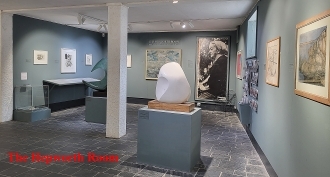An especially wonderful art gallery in a town in Cornwall
DESPITE BEING OVERRUN with tourists, the small fishing port of St Ives is one of my favourite places in Cornwall. Since the early 19th century, this picturesque place has attracted artists. With the decline of the pilchard industry in the 1880s, many of the buildings associated with this became vacant, and some of them were occupied by artists who converted them into studios. With the advent of the railway (in 1877), a means for easily transporting large canvases to London became available. It was not long before St Ives became an artists’ ‘colony’. In 1889, the St Ives Arts Club was founded as a place where artists could meet and socialise. It still exists. Its ground floor is used for temporary exhibitions. The upper floor is for members only, but I was lucky enough to have visited it with my friend, the late Michael Jacobs, who was writing his book, “Good and Simple Life: Artist Colonies in Europe and America”.
In 1927, the St Ives Society of Artists was formed. Its aim was (and still is) to raise the artistic standards of the artists’ colony and to exhibit works that they considered to be of significant quality. It was housed in various buildings in the town before 1945, when it moved into its present accommodation, the deconsecrated gothic church of St Nicholas. Exhibitions are held both in the church itself and in the crypt below it. The works of St Ives artists, who were considered avant-garde, such as Barbara Hepworth, Peter Lanyon, and Patrick Heron, were displayed alongside those of the town’s less adventurous artists, but were given less favourable positions in the exhibitions than the conventional creations. In 1946, several of the modernist artists held an exhibition in the crypt. They became members of a newly created Crypt Group. There were a couple more exhibitions by members of the Crypt Group in 1947 and the following year. Following a disagreement at an extraordinary general meeting of the Society in 1948, many of the members resigned including those who were included in the Crypt Group – some of Britain’s leading modern artists of the time.

In 1949, some of the modernist artists in St Ives, including Barbara Hepworth, Ben Nicholson, Peter Lanyon, Bernard Leach, Sven Berlin and Wilhelmina Barns-Graham, founded a new organisation – The Penwith Society. Later members included the sculptor Henry Moore, Terry Frost, and Patrick Heron. Because of its association with Britain’s pioneers of modern art, the Penwith is a tangible, important landmark in 20th century British art history. In 1961, the Penwith occupied a disused pilchard packing factory, and over the years it has expanded into neighbouring buildings. As its website (https://penwithgallery.com/about-us/) explained:
“Today the Penwith offers a year-round programme of exhibitions by Society Members and Associates, as well as those by other artists from Cornwall and further afield. The Penwith continues to be at the forefront of presenting contemporary work of quality.”
Every time we visit St Ives, we visit the Penwith. Of all the numerous (commercial) galleries in St Ives, the Penwith consistently contains artworks of the highest quality and greatest visual interest. The exhibition areas are spacious and well-lit. One area in the gallery is called the ‘Hepworth Room’, which is used for exhibitions, but also contains a fine sculpture by Barbara Hepworth. A small courtyard, used to exhibit sculptures, contains a plaque, which reads:
“This foundation stone was laid by our friend and benefactor Dame Barbara Hepworth 10 January 1973”
It must refer to one of the many extensions made to the place since it was adopted by the Penwith in 1961.
I always enjoy visiting the Penwith. My advice to a visitor, who is short of time, is to forget the Tate St Ives, and instead make a beeline for the Penwith. Having said that, the Barbara Hepworth Sculpture Garden should also not be missed.



